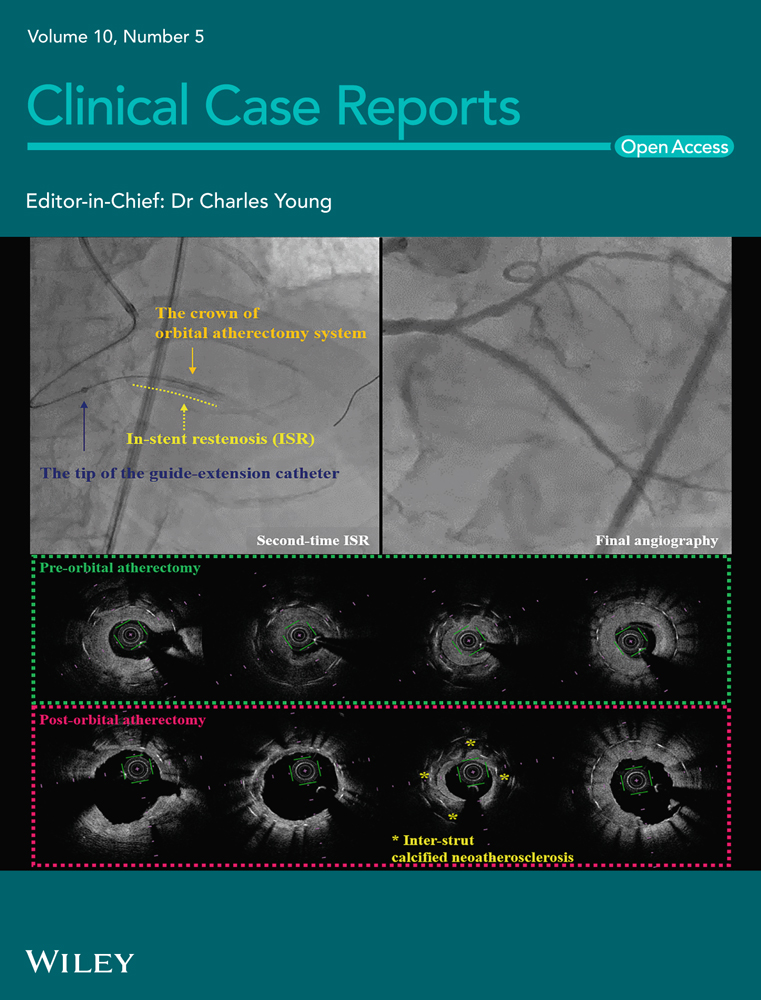Case of follicular mucinosis showing brownish yellow and red dots via dermoscopy
Funding information
The authors received no financial support for this study
Abstract
We herein describe a 68-year-old man with follicular mucinosis. A dermoscopic examination showed multiple, round, brownish yellow dots with a whitish rim in the follicular ostium and red dots in the interfollicular area. This case report is the first to suggest that follicular mucinosis shows these dermoscopic findings.
1 INTRODUCTION
Follicular mucinosis, also referred to as alopecia mucinosa, was initially reported as localized alopecia, which is histopathologically characterized by the deposition of mucin within hair follicles.1 It is classified as idiopathic follicular mucinosis, which is not associated with other cutaneous or extracutaneous diseases, and as lymphoma-associated follicular mucinosis, which is associated with mycosis fungoides or Sézary syndrome.2 Idiopathic follicular mucinosis commonly appears as follicular papules or indurated plaques.3 We herein report a case of idiopathic follicular mucinosis showing characteristic dermoscopic findings.
2 CASE REPORT
A 68-year-old Japanese man with a reddish plaque on the forehead for several years and alopecia on the scalp for 9 months was referred to our department. The patient had no applicable medical or medication history but had asthma in his childhood. A physical examination revealed alopecic reddish plaques measuring 3 cm in diameter on the forehead and scalp (Figure 1A). Lymph nodes were not swollen around the head or neck. A dermoscopic examination of the reddish plaque on the forehead showed multiple, round, brownish yellow dots with a whitish rim in the follicular ostium and red dots in the interfollicular area (Figure 1B,C). A peripheral blood examination revealed no increases in the level of the soluble interleukin 2 receptor or the number of atypical lymphocytes. A histopathological examination with hematoxylin & eosin staining showed (i) an eosinophilic substance in the dilated infundibulum and a pale basophilic substance in the isthmus and outer root sheath (Figure 1D), (ii) focal follicular spongiosis and vacuolar alterations at the interface between the outer root sheath and the dermis, (iii) the follicular and perifollicular infiltration of lymphocytes without atypia, and (iv) dilated capillary vessels in the upper dermis. The substance deposited in hair follicles was stained with Alcian blue at pH 2.5 (Figure 1E). Based on these findings, the patient was diagnosed with idiopathic follicular mucinosis and the relevant alopecia. The patient was treated 4 times each month with triamcinolone acetonide injections, which resulted in the attenuation of lesions after 4 months (Figure 1F).

3 DISCUSSION
Only one English study has described multiple papular lesions on an erythematous background as the dermoscopic finding of follicular mucinosis.3 In the present case, the histopathological finding of mucin deposits in the follicular infundibulum and isthmus appeared to correspond to the dermoscopic findings of brownish yellow dots in the follicular ostium and the histopathological findings of dilated capillary vessels to the dermoscopic findings of red dots in the interfollicular area.
Yellow dots are a trichoscopic finding that corresponds to a dilated follicular infundibulum filled with keratotic material and/or sebum. They are observed as rounded or polycyclic structures with colors ranging from pinkish to brownish yellow.4 This finding has been detected in various diseases, such as alopecia areata, chronic cutaneous lupus erythematosus, androgenetic alopecia, and dissecting cellulitis and, less frequently, in trichotillomania.5 Therefore, the brownish yellow dots identified in the present case are not specific to follicular mucinosis.
Red dots are a dermoscopic finding that corresponds to dilated vessels aligned perpendicular to the skin surface.6 This finding has been detected in melanocytic lesions, such as melanoma and melanocytic nevus, as well as in inflammatory diseases, including psoriasis.6 Therefore, the red dots observed in the present case are not specific to follicular mucinosis. In this context, the combination of both brownish yellow dots and red dots appears to be nonspecific. However, this case report suggests that dermatologists need to consider follicular mucinosis when these dermoscopic findings are obtained.
AUTHOR CONTRIBUTIONS
HY: contributed to validation and writing. MO: provided resources and contributed to data curation. YN: performed project administration. AA: provided supervision.
ACKNOWLEDGMENTS
None.
CONFLICT OF INTEREST
None declared.
ETHICAL APPROVAL
The case report was approved by the Ethics Committee of The Jikei University School of Medicine, and written informed consent was obtained from the patient.
CONSENT
Written informed consent was obtained from the patient to publish this report in accordance with the journal's patient consent policy.




